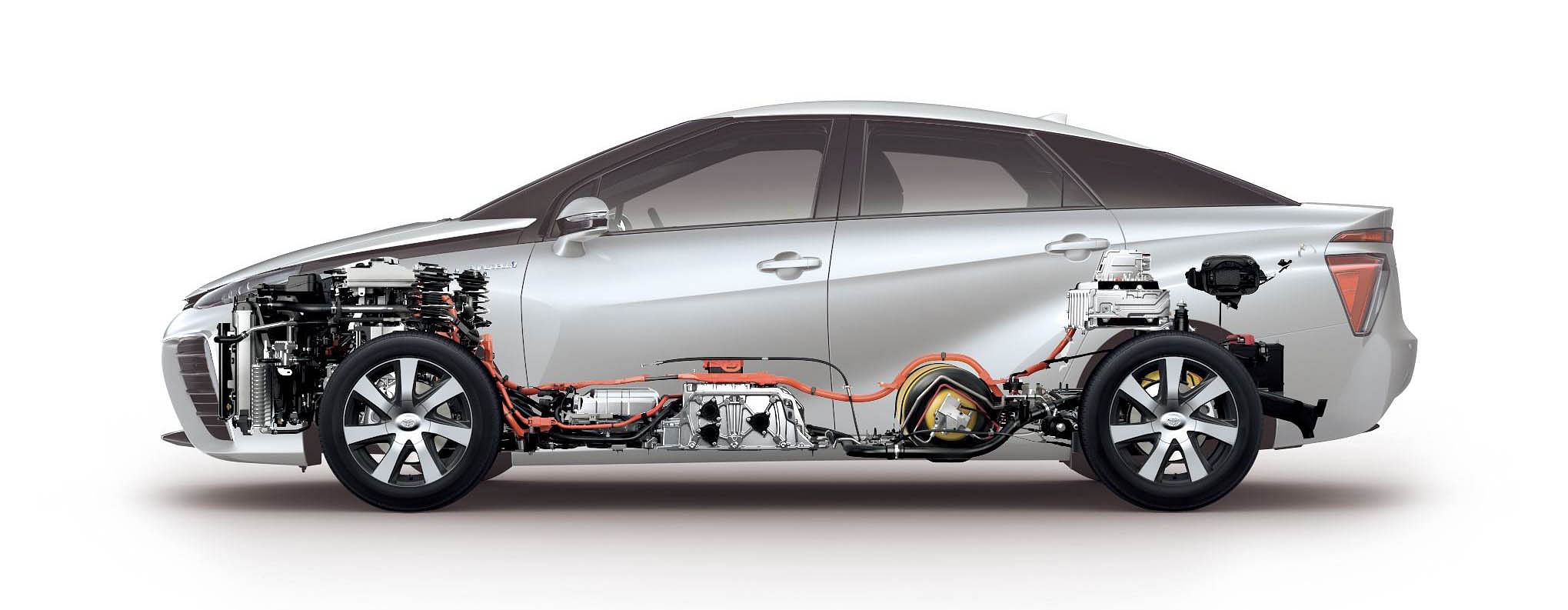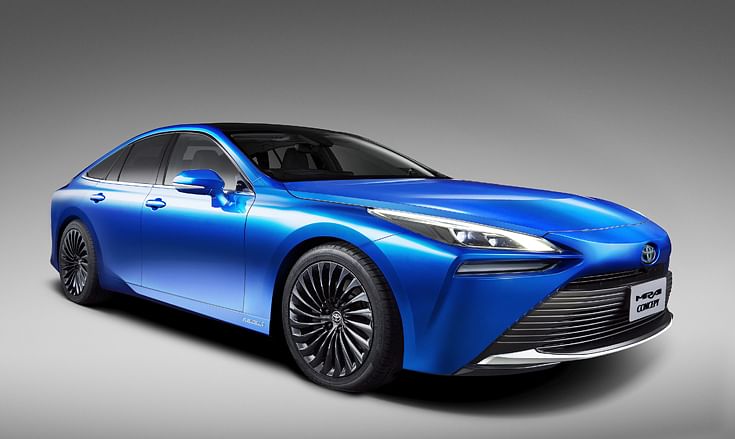Toyota showcases FCEV tech to Union ministers
The Minister of Road Transport & Highways gets a feel of the world's first first hydrogen fuel cell sedan, showcased as a pilot project in India.
Nitin Gadkari, Minister of Road Transport & Highways, Micro, Small & Medium Enterprises Government of India, has taken a brief experiential drive in the Toyota Mirai, the pioneering fuel cell electric vehicle (FCEV) from the Japanese carmaker.
Following his drive in the hydrogen-powered Toyota sedan, Gadkari, who has been accelerating the movement for more eco-friendly solutions in the country, tweeted: “Hydrogen fuel is the eco-friendly alternative to petrol and diesel, which would fuel a more sustainable tomorrow. Happy to ride the hybrid cars of Toyota, this will prove to be a milestone in our fight against global warming.”
Vikram Kirloskar, vice-chairman of Toyota Kirloskar Motor, tweeted: “Thank you, @nitin_gadkari . I hope you enjoyed the experiential drive in the #ToyotaMirai. @Toyota_India has always been committed leading the way towards a cleaner & greener future & the electrification of vehicles will help reduce CO2 emissions.”
Meanwhile, Dharmendra Pradhan, Cabinet Minister for Petroleum & Natural Gas and Steel, government of India, also tweeted: “Experienced @Toyota_India's new Hydrogen Fuel Cell based car. In the rapidly evolving energy landscape, hydrogen offers an eco-friendly and innovative solution for sustainable and green transportation fuel. Delighted to learn that the only emissions from this car is water.”
The showcasing of the hybrid technology cars, along with the Mirai, in India can be seen as an example of Toyota's argument in favour of hybrids at this stage in the journey towards fully electrification.

Using hydrogen to generate electricity within a fuel cell stack, the Toyota Mirai produces no tailpipe emissions other than water.
Hydrogen power
The Mirai (which means ‘future’ in Japanese) is the world’s first hydrogen fuel cell sedan, benefiting from Toyota’s research and development of the fuel cell technology spanning for over two decades, and world-leading experience in hybrid vehicle power systems. The Mirai is a four-door, midsize sedan with performance that fully competes with traditional internal combustion engines – but does not use petrol. Instead, Mirai creates electricity on demand using hydrogen, oxygen and a fuel cell, and emits nothing but water vapour in the process.
Using hydrogen to generate electricity within a fuel cell stack, the Mirai produces no tailpipe emissions other than water. In addition, a full-tank driving range of around 500 kilometres bears comparison with a petrol-powered car and the refuelling process only takes about three minutes to complete.
Launched in 2014, the first-generation Toyota Mirai proved the global potential of hydrogen to power clean and sustainable mobility, combining a driving range with refueling time equivalent to conventional vehicles and emissions of nothing but water. Since then, approximately 10,000 Mirais have been sold globally, helping pave the way towards a hydrogen society that will reduce emissions, diversify energy sources, and generate global economic growth.
It may be recollected that in an exclusive interview with Autocar Professional in September 2019, N Raja, Deputy Managing Director, Toyota Kirloskar Motor, had said that the company would be showcasing a hydrogen-powered car later in the year.
“We have always been vouching for technology and movement towards EVs. Toyota Motor Corporation globally is working towards zero fossil fuels by 2050 as a major policy. That is the way forward and we acknowledge it by working towards that direction. What we are trying to say is that in the current ecosystem, for India, with its infrastructural challenges, the path for EVs moves through hybrids. For example, our Camry Hybrid meets BS VI emission levels and fuel efficiency is 40-45 percent better. So hybrid is a gradual shift. Nowhere are we saying EVs are not suitable. In fact, globally, we are working on EVs as a technology. But in India, EV pricing and charging infrastructure remain a key challenge."
"What we are saying is to stay technology agnostic as long as the final result of environment protection and reduction in pollution is met. The moment infrastructure is available in the country, we will start to move in. Today, we are BS VI-ready, hybrid as a technology is available with us, we are trying to bring in the plug-in hybrid, and our work on EVs is also underway. What's more, we also have fuel cells and hydrogen cars with us. In fact, Toyota is one of the few automakers which have commercialised hydrogen cars, which are now available in Japan, the USA and Dubai. We are trying to bring a car as a pilot in India. Therefore, as far as technologies are concerned, we have all of them available with us,” Raja had said.
Next-gen Mirai showcased at Tokyo Motor Show
In end-October, Toyota revealed the Mirai Concept, a final-stage development model of the second-generation Mirai, at the Tokyo Motor Show 2019.
Toyota promises a major step forward in FCEV technology with this model. It claims the new model offers a 30 percent increase in driving range over the current model. The second-gen model has a claimed range of over 483km, along with improved driving performance.

The new Mirai Concept is built on Toyota’s latest TNGA platform, and features dramatic new styling including a revamped front with a bold grille, and a sweeping, coupé-like rear. Toyota claims increased body rigidity and a lower centre of gravity.
The concept measures 4,935mm long and 1,885mm wide, with a wheelbase of 2,920mm. It sits on 20-inch wheels, and retains the four-door sedan layout of the original Mirai, which was launched in 2014.
The interior has also been reworked, featuring a 12.3-inch central touchscreen and a digital instrument display, with many of the controls moved to the centre of the dashboard. Notably, the Mirai now has five seats instead of the original four, which Toyota says has been enabled by a reworking of the hydrogen fuel-cell configuration.
Aside from the claimed increase in range, Toyota has not given specific details of development work done on the fuel-cell powertrain. However, it says that the system, including the fuel-cell stack, has been entirely redesigned and offers increased hydrogen storage. It also claims that the work on the system ensures a smoother, linear response, along with improved handling.
Also read:
RELATED ARTICLES
JSW MG Motor India confident of selling 1,000 M9 electric MPVs in first year
The 5.2-metre-long, seven-seater luxury electric MPV, which will be locally assembled at the Halol plant in Gujarat, wil...
Modern Automotives targets 25% CAGR in forged components by FY2031, diversifies into e-3Ws
The Tier-1 component supplier of forged components such as connecting rods, crankshafts, tie-rods, and fork bridges to l...
VinFast’s second plant in Vietnam goes on stream ahead of India factory
Vietnamese EV maker’s second plant in its home market, which has a 200,000 EVs-per-annum capacity, will focus on produci...





 By Autocar Professional Bureau
By Autocar Professional Bureau
 07 Dec 2019
07 Dec 2019
 17320 Views
17320 Views




















